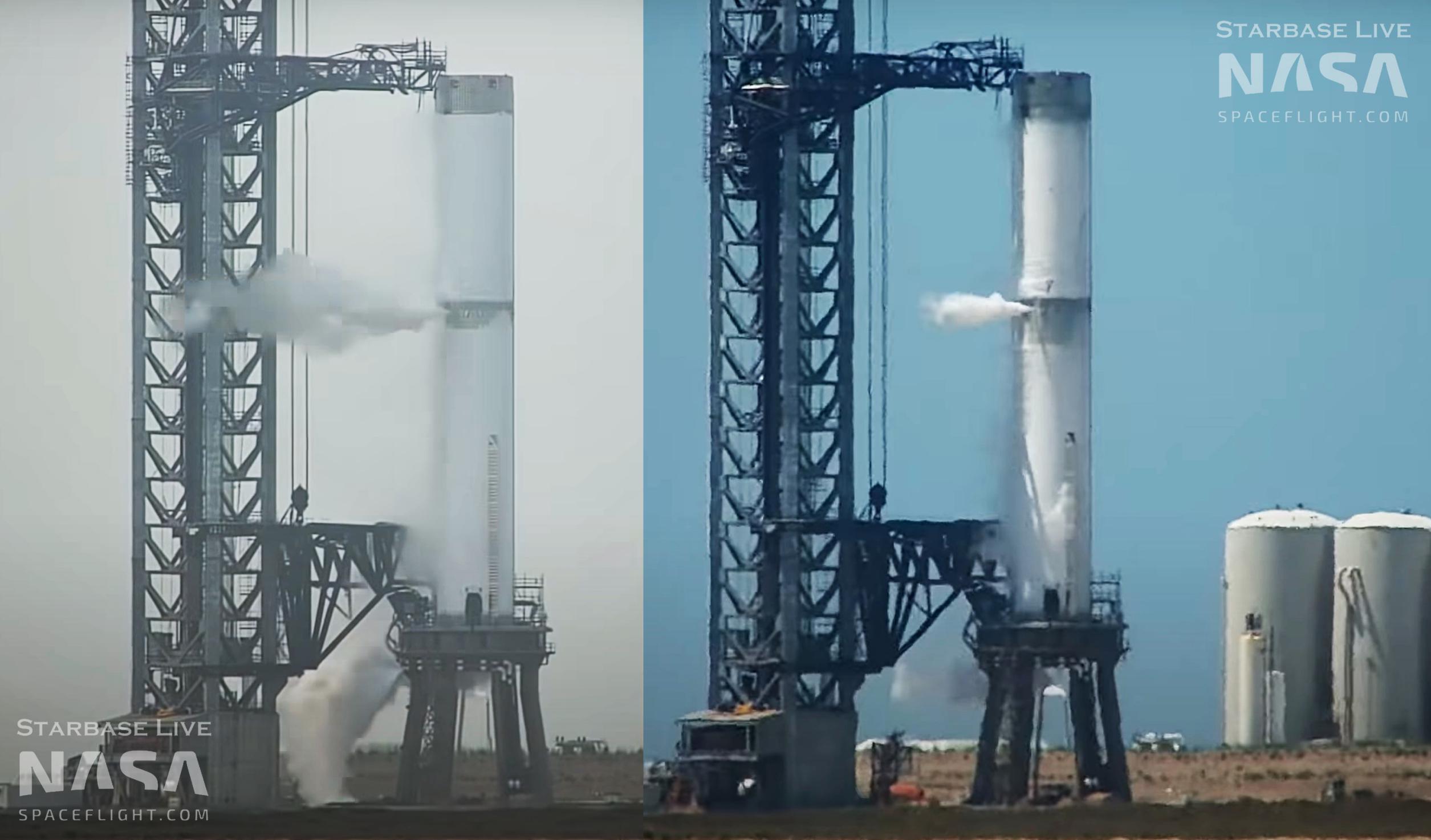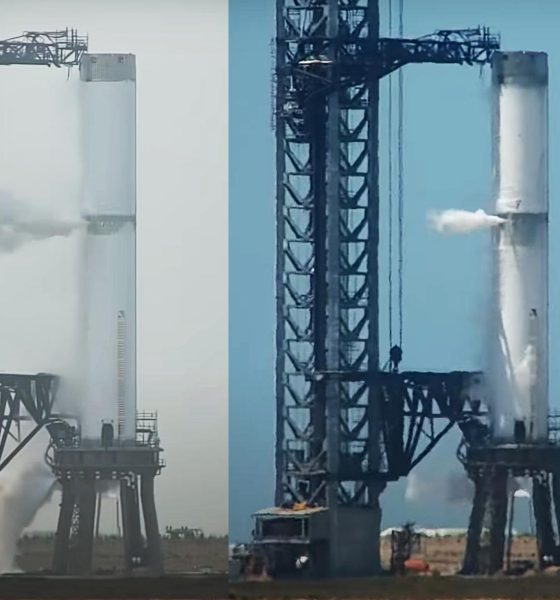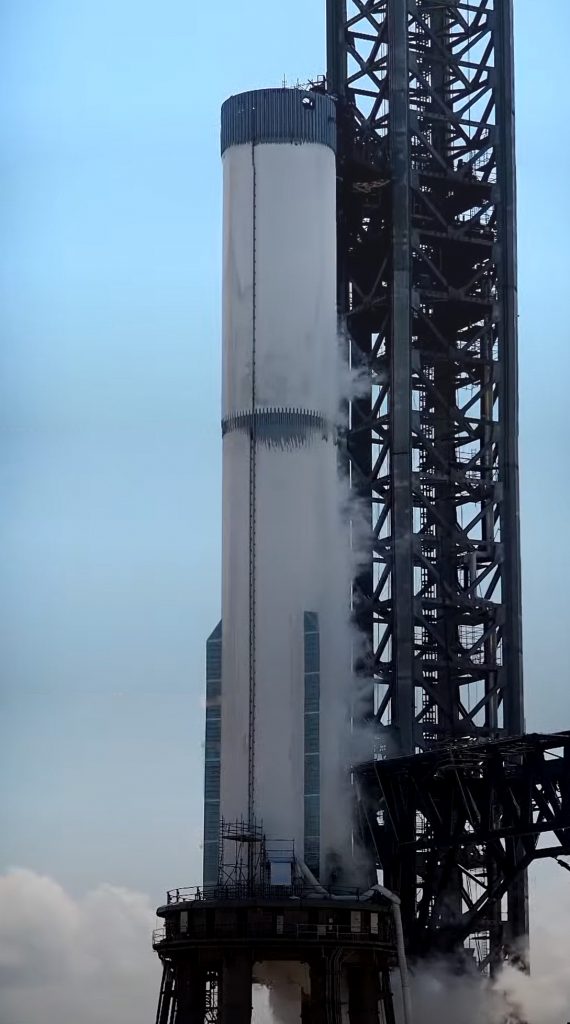

News
SpaceX’s repaired Starship booster survives back-to-back cryoproof tests
SpaceX’s upgraded Starship booster has completed a second and third cryogenic proof test in rapid succession after undergoing repairs to fix damage suffered during the first round of testing.
Testing began almost immediately after SpaceX rolled the repaired Super Heavy booster back to the orbital launch site (OLS) on May 6th. After a quick installation on the pad’s stool-like launch mount and another day of systems checks and integration, Booster 7 charged headfirst into its first post-repair cryoproof on May 9th.
Instead of cautiously feeling out the repaired plumbing and header tank over a series of small tests, SpaceX immediately performed a full cryogenic proof (cryoproof) and filled Booster 7 to the brim with about 3000 tons (~6.6M lb) of liquid nitrogen (LN2) or a combination of LN2 and liquid oxygen (LOx). Standing about 67 meters (~220 ft) tall and 9 meters (~30 ft) wide, it took about two hours to fully fill Super Heavy’s tanks with the equivalent of one and a half Olympic swimming pools of cryogenic liquid.
As always, that liquid (well below –320°F or –196°C) rapidly chilled the booster’s 4mm (~0.16″) thick steel tanks to cryogenic temperatures, which then froze moisture directly out of the humid Texas air, coating almost all of Super Heavy’s exterior with a layer of frost and ice.

SpaceX began detanking Booster 7 soon after the fill process was completed. Thanks to plenty of insulated plumbing and well-insulated ground storage tanks, SpaceX is able to recover nearly all of the LN2 and LOx used during cryoproof testing, which helps avoid the hundreds of semi-truck delivers that would otherwise be required to replenish the tank farm after even a single test.
As if to demonstrate that, SpaceX proceeded to put Booster 7 through a whole new cryogenic proof test just two days later, on May 11th. Once again, Super Heavy was fully loaded with thousands of tons of liquid nitrogen and oxygen. Unlike Cryoproof #2’s immediate detank, SpaceX – judging by the frost levels – kept Booster 7 topped off for a good hour before detanking.
In a last-minute surprise, after fully detanking B7 at the end of Cryoproof #3, SpaceX refilled the booster’s liquid oxygen tank with a few hundred tons of LN2 or LOx. Once the rocket’s thrust section reached some degree of thermodynamic equilibrium, SpaceX remotely retracted and reconnected the orbital launch mount’s Super Heavy umbilical. The launch mount umbilical or ‘quick disconnect’ is responsible for connecting Super Heavy to the pad’s gas supplies, propellant storage, power, and communications. The test SpaceX completed after Cryoproof #3 may have been a rough simulation of one scenario Starship could easily face: a post-ignition launch abort. In other words, if an orbital Starship launch was aborted just before liftoff but after quick-disconnect retraction, could it quickly reconnect to the booster with zero human intervention?
In a scenario where a QD failed to reattach to a fully-fueled Super Heavy after a launch abort, the odds of a catastrophic fire or explosion would immediately shoot up to near-certainty. In moderate quantities, simultaneously venting gaseous methane and oxygen from the same rocket is risky but manageable. Venting hundreds – let alone thousands – of tons while trapped on the ground would amount to creating a multi-hour fuel-air bomb just waiting for a spark. Multiple Starship prototypes (SN4, SN10) have already been destroyed in part by the flammability of methane gas.

Combined with the completion of two full cryogenic proof tests in less than two days, it appears that Super Heavy B7’s repairs were extremely successful. Had the first post-repair cryoproof not gone more or less perfectly, it’s hard to imagine that SpaceX would have attempted or completed an almost identical test two days later. If the second cryoproof hadn’t been nearly perfect, it’s even harder to imagine that SpaceX would have accepted the risk involved in detaching Booster 7’s umbilical during the same test window.
On May 12th, SpaceX’s main pad crane attached a lift jig to Super Heavy B7, implying that it will likely be removed from the orbital launch mount in the near future. If the repaired booster aced its tests, SpaceX’s next step would likely be Raptor engine installation and the start of static fire testing. It’s unclear if SpaceX wants to install all 33 engines at once or begin with a small handful. It’s also unclear if SpaceX will return Booster 7 to Starbase’s production facilities to finish Raptor, heat shield, grid fin, and aerocover installation.

Elon Musk
Elon Musk confirms xAI’s purchase of five 380 MW natural gas turbines
The deal, which was confirmed by Musk on X, highlights xAI’s effort to aggressively scale its operations.

xAI, Elon Musk’s artificial intelligence startup, has purchased five additional 380 MW natural gas turbines from South Korea’s Doosan Enerbility to power its growing supercomputer clusters.
The deal, which was confirmed by Musk on X, highlights xAI’s effort to aggressively scale its operations.
xAI’s turbine deal details
News of xAI’s new turbines was shared on social media platform X, with user @SemiAnalysis_ stating that the turbines were produced by South Korea’s Doosan Enerbility. As noted in an Asian Business Daily report, Doosan Enerbility announced last October that it signed a contract to supply two 380 MW gas turbines for a major U.S. tech company. Doosan later noted in December that it secured an order for three more 380 MW gas turbines.
As per the X user, the gas turbines would power an additional 600,000+ GB200 NVL72 equivalent size cluster. This should make xAI’s facilities among the largest in the world. In a reply, Elon Musk confirmed that xAI did purchase the turbines. “True,” Musk wrote in a post on X.
xAI’s ambitions
Recent reports have indicated that xAI closed an upsized $20 billion Series E funding round, exceeding the initial $15 billion target to fuel rapid infrastructure scaling and AI product development. The funding, as per the AI startup, “will accelerate our world-leading infrastructure buildout, enable the rapid development and deployment of transformative AI products.”
The company also teased the rollout of its upcoming frontier AI model. “Looking ahead, Grok 5 is currently in training, and we are focused on launching innovative new consumer and enterprise products that harness the power of Grok, Colossus, and 𝕏 to transform how we live, work, and play,” xAI wrote in a post on its website.
Elon Musk
Elon Musk’s xAI closes upsized $20B Series E funding round
xAI announced the investment round in a post on its official website.

xAI has closed an upsized $20 billion Series E funding round, exceeding the initial $15 billion target to fuel rapid infrastructure scaling and AI product development.
xAI announced the investment round in a post on its official website.
A $20 billion Series E round
As noted by the artificial intelligence startup in its post, the Series E funding round attracted a diverse group of investors, including Valor Equity Partners, Stepstone Group, Fidelity Management & Research Company, Qatar Investment Authority, MGX, and Baron Capital Group, among others.
Strategic partners NVIDIA and Cisco Investments also continued support for building the world’s largest GPU clusters.
As xAI stated, “This financing will accelerate our world-leading infrastructure buildout, enable the rapid development and deployment of transformative AI products reaching billions of users, and fuel groundbreaking research advancing xAI’s core mission: Understanding the Universe.”
xAI’s core mission
Th Series E funding builds on xAI’s previous rounds, powering Grok advancements and massive compute expansions like the Memphis supercluster. The upsized demand reflects growing recognition of xAI’s potential in frontier AI.
xAI also highlighted several of its breakthroughs in 2025, from the buildout of Colossus I and II, which ended with over 1 million H100 GPU equivalents, and the rollout of the Grok 4 Series, Grok Voice, and Grok Imagine, among others. The company also confirmed that work is already underway to train the flagship large language model’s next iteration, Grok 5.
“Looking ahead, Grok 5 is currently in training, and we are focused on launching innovative new consumer and enterprise products that harness the power of Grok, Colossus, and 𝕏 to transform how we live, work, and play,” xAI wrote.
Investor's Corner
Tesla gets price target bump, citing growing lead in self-driving

Tesla (NASDAQ: TSLA) stock received a price target update from Pierre Ferragu of Wall Street firm New Street Research, citing the company’s growing lead in self-driving and autonomy.
On Tuesday, Ferragu bumped his price target from $520 to $600, stating that the consensus from the Consumer Electronics Show in Las Vegas was that Tesla’s lead in autonomy has been sustained, is growing, and sits at a multiple-year lead over its competitors.
CES 2026 validates Tesla’s FSD strategy, but there’s a big lag for rivals: analyst
“The signal from Vegas is loud and clear,” the analyst writes. “The industry isn’t catching up to Tesla; it is actively validating Tesla’s strategy…just with a 12-year lag.”
The note shows that the company’s prowess in vehicle autonomy is being solidified by lagging competitors that claim to have the best method. The only problem is that Tesla’s Vision-based approach, which it adopted back in 2022 with the Model 3 and Model Y initially, has been proven to be more effective than competitors’ approach, which utilizes other technology, such as LiDAR and sensors.
Currently, Tesla shares are sitting at around $433, as the company’s stock price closed at $432.96 on Tuesday afternoon.
Ferragu’s consensus on Tesla shares echoes that of other Wall Street analysts who are bullish on the company’s stock and position within the AI, autonomy, and robotics sector.
Dan Ives of Wedbush wrote in a note in mid-December that he anticipates Tesla having a massive 2026, and could reach a $3 trillion valuation this year, especially with the “AI chapter” taking hold of the narrative at the company.
Ives also said that the big step in the right direction for Tesla will be initiating production of the Cybercab, as well as expanding on the Robotaxi program through the next 12 months:
“…as full-scale volume production begins with the autonomous and robotics roadmap…The company has started to test the all-important Cybercab in Austin over the past few weeks, which is an incremental step towards launching in 2026 with important volume production of Cybercabs starting in April/May, which remains the golden goose in unlocking TSLA’s AI valuation.”
Tesla analyst breaks down delivery report: ‘A step in the right direction’
Tesla has transitioned from an automaker to a full-fledged AI company, and its Robotaxi and Cybercab programs, fueled by the Full Self-Driving suite, are leading the charge moving forward. In 2026, there are major goals the company has outlined. The first is removing Safety Drivers from vehicles in Austin, Texas, one of the areas where it operates a ride-hailing service within the U.S.
Ultimately, Tesla will aim to launch a Level 5 autonomy suite to the public in the coming years.








